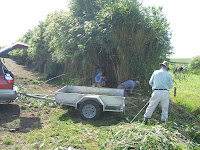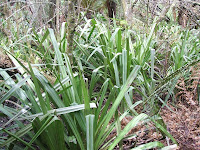
Hamilton City Council rang this morning to say they had “left over” plants in their nursery and seeing we had damp areas in the areas of the gully we have cleared of honeysuckle would we like a selection of understory plants to plant out. I was going to be over that side of town this morning with my trailer so I arrange to call into the nursery and pick them up. The result is we have approximately (a bit hard to count on the trailer) 160 eco-sourced native plants to plant at tomorrow’s (Wednesday) working bee. Isn’t that great?
This is not just about Council “getting rid” of end of season stock it is acknowledgement by council of the good work our group has done and a means of supporting our effects.
There will be four of us at the working bee tomorrow but with this number of plants to plant out a few extra hands would be good. I know most of you have a job to go to but those that don’t and have a free morning it would be good to see you.
We meet at the St James side of the walk bridge at 8.45am (or when you can make it). Bring a spade (smaller the better) and a garden trowel. Some plants are quite small, and a drink & morning tea for yourself.
This is not just about Council “getting rid” of end of season stock it is acknowledgement by council of the good work our group has done and a means of supporting our effects.
There will be four of us at the working bee tomorrow but with this number of plants to plant out a few extra hands would be good. I know most of you have a job to go to but those that don’t and have a free morning it would be good to see you.
We meet at the St James side of the walk bridge at 8.45am (or when you can make it). Bring a spade (smaller the better) and a garden trowel. Some plants are quite small, and a drink & morning tea for yourself.
Plant varieties and numbers:
Melicytus micranthus x 42
Coprosma grandifolia Rauekau x 25
Coprosma tenuicalis Swamp Coprosma x 2
Coprosma propinqua Mingimingi x 30
Geniostoma rupestre Hangehange x 23
Kunzea ericoides Kanuka x 7
Coprosma rhamnoides Red fruited Karamu x 15
Beilschmiedia tawa Tawa x 5
Alectryon execelsus Titoki x 10
Aristotelia serrata Wine Berry Makomako x 1
Coprosma grandifolia Rauekau x 25
Coprosma tenuicalis Swamp Coprosma x 2
Coprosma propinqua Mingimingi x 30
Geniostoma rupestre Hangehange x 23
Kunzea ericoides Kanuka x 7
Coprosma rhamnoides Red fruited Karamu x 15
Beilschmiedia tawa Tawa x 5
Alectryon execelsus Titoki x 10
Aristotelia serrata Wine Berry Makomako x 1





























